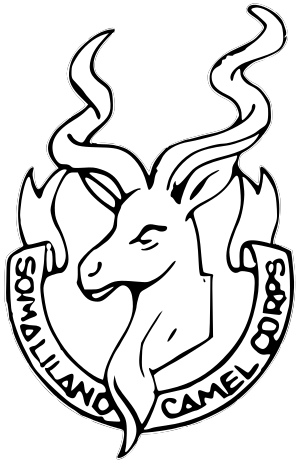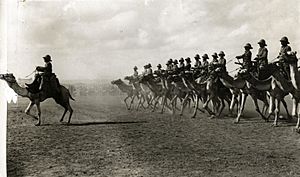Somaliland Camel Corps facts for kids
Quick facts for kids Somaliland Camel Corps |
|
|---|---|

Logo of the Somaliland Camel Corps
|
|
| Active | Early 20th century - disbanded in 1944 and succeeded by the Somaliland Scouts. |
| Country | |
| Allegiance | |
| Branch | Rayid Cavalry |
| Type | Camel Cavalry |
| Headquarters | Laferug (Lafaruug) |
| Engagements | Somaliland Campaign Second Somaliland expedition Third Somaliland expedition Fifth Somaliland expedition 1922 Burao Tax Revolt Italian conquest of British Somaliland East African Campaign 1945 Sheikh Bashir Rebellion |
| Commanders | |
| Notable commanders |
Hastings Ismay, 1st Baron Ismay Eric Charles Twelves Wilson |
The Somaliland Camel Corps (often called the SCC) was a special group of soldiers who rode camels. They were part of the British Army and were based in a place called British Somaliland (which is now part of Somaliland). This group existed from the early 1900s until 1944.
Contents
How the Camel Corps Started
In 1888, the British made agreements with the local Somali leaders. This led to the creation of a "protectorate" in northern Somaliland. A protectorate is like a country that is protected and partly controlled by a stronger country. This area was called British Somaliland.
The British quickly saw that Somali people were very good with camels. So, they tried to use this skill for military purposes. An early group called the "Somali Camel Constabulary" was formed.
Around 1895, a group called the Dervishes started to challenge the colonial powers. Fighting began in 1900 and lasted until 1920.
Fighting in the Somaliland Campaign
On August 9, 1913, the "Somaliland Camel Constabulary" faced a big defeat. This happened at the Battle of Dul Madoba. Fifty-seven out of 110 soldiers were killed or hurt, including their commander, Colonel Richard Corfield.
After this, on March 12, 1914, the British decided to create the Somaliland Camel Corps. Their job was to keep order in the protectorate. The corps fought against the Dervishes, whose leader was sometimes called the "Mad Mullah." Even after four big attempts, the leader was still free.
During this time, the corps showed how tough they were. They traveled about 150 miles (240 km) in just 72 hours! The SCC grew to have about 700 camel riders.
In November 1919, the British started their fifth major effort against the Dervishes. In 1920, they launched a combined attack using soldiers on the ground and airplanes. The Somaliland Camel Corps, along with the Royal Air Force, police, and other African and Indian soldiers, defeated the Dervish army. They also took over the Dervish capital.
Between the two World Wars, the SCC was reorganized. This was to make it better at defending the protectorate if another war started. In 1930, Colonel Arthur Reginald Chater took command of the corps, which then had about 500 soldiers. Like many other colonial units, the SCC had British officers leading the Somali soldiers, called Askari.
In the late 1930s, the corps received money to build small forts called pillboxes and water tanks. After a financial crisis in 1931, the SCC had 14 British officers, 400 Somali Askari, and 150 African Reservists.
The Somaliland Camel Corps in World War II
In September 1939, when World War II began, the Somaliland Camel Corps had 14 British officers, one British non-commissioned officer, and 554 other soldiers, mostly Somalis.
The four companies of the SCC were spread out in five different places. Only one company, "A" Company, still used camels. The other companies had become regular foot soldiers.
Field Marshal Archibald Wavell, a top commander, was worried about how unprepared the force was to defend the colony. In 1940, some of the unit was given vehicles instead of camels. More defenses were also built. However, funding stopped before all the upgrades could be finished.
At the start of the East African Campaign, the Somaliland Camel Corps had 1,475 men. They were joined by soldiers from the Northern Rhodesian Regiment. They were supposed to defend British Somaliland. More soldiers were sent from Aden, but it was too late to stop the Italian invasion.
During the Italian takeover of British Somaliland, the Somaliland Camel Corps fought small battles along the border. They then pulled back to stronger defensive positions at a place called Tug Argan gap.
During the Battle of Tug Argan, from August 11-15, an officer named Captain Eric Charles Twelves Wilson showed great bravery. He was from the East Surreys regiment but was serving with the Camel Corps. He earned the Victoria Cross (VC) for using a machine gun to defend Observation Hill. The Victoria Cross is the highest award for bravery in the British military. Even though he was wounded, had malaria, and several of his guns were destroyed, he stayed at his post. Wilson was the only person to receive the VC during the Italian invasion of British Somaliland. He was later found alive in an Italian prisoner of war camp.
The British were forced to leave Berbera on August 17, 1940. Most of the Somaliland Camel Corps soldiers were sent home.
However, less than a year later, on March 16, 1941, the British returned to the colony. Soon after, the Somaliland Camel Corps was started again. By April 18, the unit was almost as strong as before. For the next few months, the Camel Corps helped round up Italian soldiers and fought against local bandits. In 1942, the Somaliland Camel Corps became a fully mechanized regiment, meaning they used vehicles instead of camels.
On April 30, 1944, six bombers from the 61 Squadron of the Royal Air Force attacked a German submarine, the U-852. The submarine was damaged, and its commander and 52 crew members came ashore. Members of the Somaliland Camel Corps captured and held them.
There were plans to send the Corps to Burma, but they were disbanded in 1944. This happened after several mutinies, which are when soldiers rebel against their officers. The Somaliland Scouts took their place that same year.
How the Corps Was Organized
In 1939, just before World War II, the Somaliland Camel Corps was set up like this:
- Headquarters Company: Located in Laferug (near Mandheera, between Berbera and Hargeysa).
- 'A' (Camel) Company: Based in Hargeisa. This was the only company still using camels.
- 'B' (Nyasa Infantry) Company: Located at Tug Argan.
- 'C' Company: Based in Burao.
- 'D' Company: Also at Tug Argan (with two smaller groups at Sheekh).
What They Wore
The soldiers of the Somaliland Camel Corps had a special uniform. It was based on the standard British Army khaki uniform. It included a knitted wool sweater and patches on the shoulders. They wore shorts with wool socks and "chaplis" (a type of sandal), boots, or sometimes went barefoot.
Their equipment included a leather belt and a leather bandolier for ammunition. Officers wore pith helmets and khaki uniforms. Other soldiers wore a "kullah" (a type of cap) with a "puggree" wrapped around it. The puggree had a long tail that hung down the back to shade their neck.
Notable Servicemen
- Arthur Reginald Chater
- Hastings Ismay, 1st Baron Ismay
- Adrian Carton de Wiart
- Henry Anthony Camillo Howard
- Ismail Mahamed Ali
- Eric Charles Twelves Wilson
- Charles Doughty-Wylie
- Duncan Glasfurd
- David Smiley
See also
- British Somaliland
- Somaliland Scouts
- Bikaner Camel Corps
- Sudan Defence Force
- King's African Rifles
- Camel cavalry


